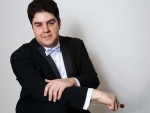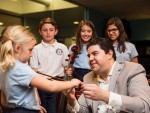Column Name
Title
Subhead
This article is condensed from one that appeared in The Arizona Republic and is reprinted with permission.
Body
The cartoon image of an orchestra conductor is that of a mad wizard, arms windmilling, frizzy locks of white hair whipping about like ball lightning.
Expect nothing of the sort from [alum] Tito Muñoz. The new music director of the Phoenix Symphony is, at 31, a relatively fresh face in the classical music scene. Affable yet reserved, his style at the podium would best be described as precise: no wild gesticulating, but instead brisk, economical motions and plain-as-day expressions with musical gist as clear to the casual appreciator as it is to the conservatory-trained instrumentalist. His era as the orchestra’s musical magician-in-chief and the public face of Arizona’s largest arts organization began in September.
Muñoz was raised in Forest Hills, Queens, as the only child of a single mother, Rosemary Ochoa. An immigrant from Ecuador, she worked as an area sales manager for UPS and later as a special-education teacher and school principal. Music was not an important part of their life together. “I actually ended up getting very involved in computers when I was young,” Muñoz says. “That was one of my outlets. If I hadn’t gone into music, I probably would have done something in computer science or network engineering.”
His first music classes didn’t make much of an impression. He took up the saxophone for one semester in elementary school, but dropped it when he showed little aptitude. But then in middle school he tried his hand at the violin and proved to be a quick study. “We were playing little arrangements of different things like the ‘Brandenburg’ Number 3 and the ‘Trepak’ from The Nutcracker, Rhapsody in Blue, all these things that I was being introduced to for the first time. And I remember getting recordings of these pieces, and of course the versions we were doing were these kind of rinky-dink arrangements, and I would listen to the recordings and I’d be like, ‘That’s not what we’re playing. That’s different. It’s better. I want to play this.’ ”
The real turning point came when his teacher recommended him for MAP, which offers world-class training to kids from backgrounds that are underrepresented in classical music, particularly African-Americans, Native Americans, and Latinos. “I’d never auditioned for anything in my life,” says Muñoz, who was 13 at the time. “I knew it was kind of a big deal, (but) I didn’t have any experience performing in a high-pressure situation, so I didn’t feel nervous at all.”
He played the first-violin part from Pachelbel’s Canon, which he had learned for his school orchestra, and made it into the program. “Juilliard was pretty much a zoo on Saturdays, with all the kids and parents running around,” he says. “Not only did I get a chance to learn from these wonderful teachers, all of whom were professionals who were working in the Philharmonic or on Broadway, (but) then the other dynamic was [seeing] people like Wynton Marsalis (’81, trumpet; director of Juilliard Jazz) and Itzhak Perlman (Pre-College ’63; ’68 violin; faculty) [in] the halls.”
The program’s purpose is to give a leg up to kids who might not otherwise have a chance at a career in classical music. It was a huge opportunity, and Muñoz ran with it—thanks in large part to a nurturing [former MAP] teacher, Hisako Resnick. “She started me from scratch,” Muñoz says. “I was one of the older kids, and she’s like, ‘Look, it’s going to be a little slow, but we’ll get there.’ But I remember I ran through the first four books of (the Suzuki Method) in those two years, and that’s maybe twice as fast as it normally takes.”
In the meantime, he enrolled at LaGuardia High School of Music & Art and Performing Arts, and after two years of MAP, he was accepted into the Manhattan School of Music precollege program. “I was in four or five youth orchestras at the same time,” he says. “And then I was also that Type-A guy, the one who would always have something to say or have an idea and want to implement it. I would always want to sit concertmaster, sit principal, because I always knew what needed to be said in order to fix something, and the only appropriate place to do that is in the front, of course. So conducting was inevitable.”
Muñoz got his first taste of leading an ensemble while working as a counselor at the French Woods arts camp. He put together a “faculty orchestra”—the teachers in this case being teenagers—to play Bach’s Third “Brandenburg” Concerto. Then, back at LaGuardia, he got to conduct West Side Story.
After graduation, he studied at the Aaron Copland School of Music at Queens College, and in 2004, the intensive conducting program at the Aspen Music Festival and School in Colorado. “I was the youngest one there and definitely a fish out of water, because everybody else already had jobs or they were getting their doctorate in conducting. Andrew Grams was there, Damon Gupton [a conductor who was in Drama Group 28] was there, Carolyn Kuan was there, all these people who were already in careers, and I was a violin major at Queens College. I didn’t know anything.”
In 2006, at age 22, he was appointed assistant conductor of Cincinnati Symphony Orchestra, and the next year he took the same position at the Cleveland Orchestra. Most recently he served as music director of the Opera National de Lorraine and Orchestre Symphonique et Lyrique de Nancy in France. And [just over a year ago], he was hired by the Phoenix Symphony.
[While the orchestra’s season started out with traditional fare, Muñoz is also interested in contemporary repertoire; his season finale, on May 22 and 23, will feature Finding Rothko by Adam Schoenberg (M.M. ’05, D.M.A. ’10, composition) as well as Mahler’s First Symphony.] Muñoz also supports collaborations with popular music, no matter how controversial such experiments can be with classical purists. “That is happening and is going to keep happening,” he says. [This season, the orchestra has played or will be presenting the music of Queen, Led Zeppelin, Nashville legends, and ’80s music, among others.] “That kind of stuff is where we need to be looking for ideas, because when you think about Dvořák, you think about Smetana, you think about Bartók going into the hills and getting folk music and creating pieces out of that, how is that any different?”
Of course, the maestro doesn’t have to be in a hurry to figure out how he and the Phoenix Symphony will contribute to the international dialogue on the future of music. He is young yet, and the Tito Muñoz era is just beginning.






